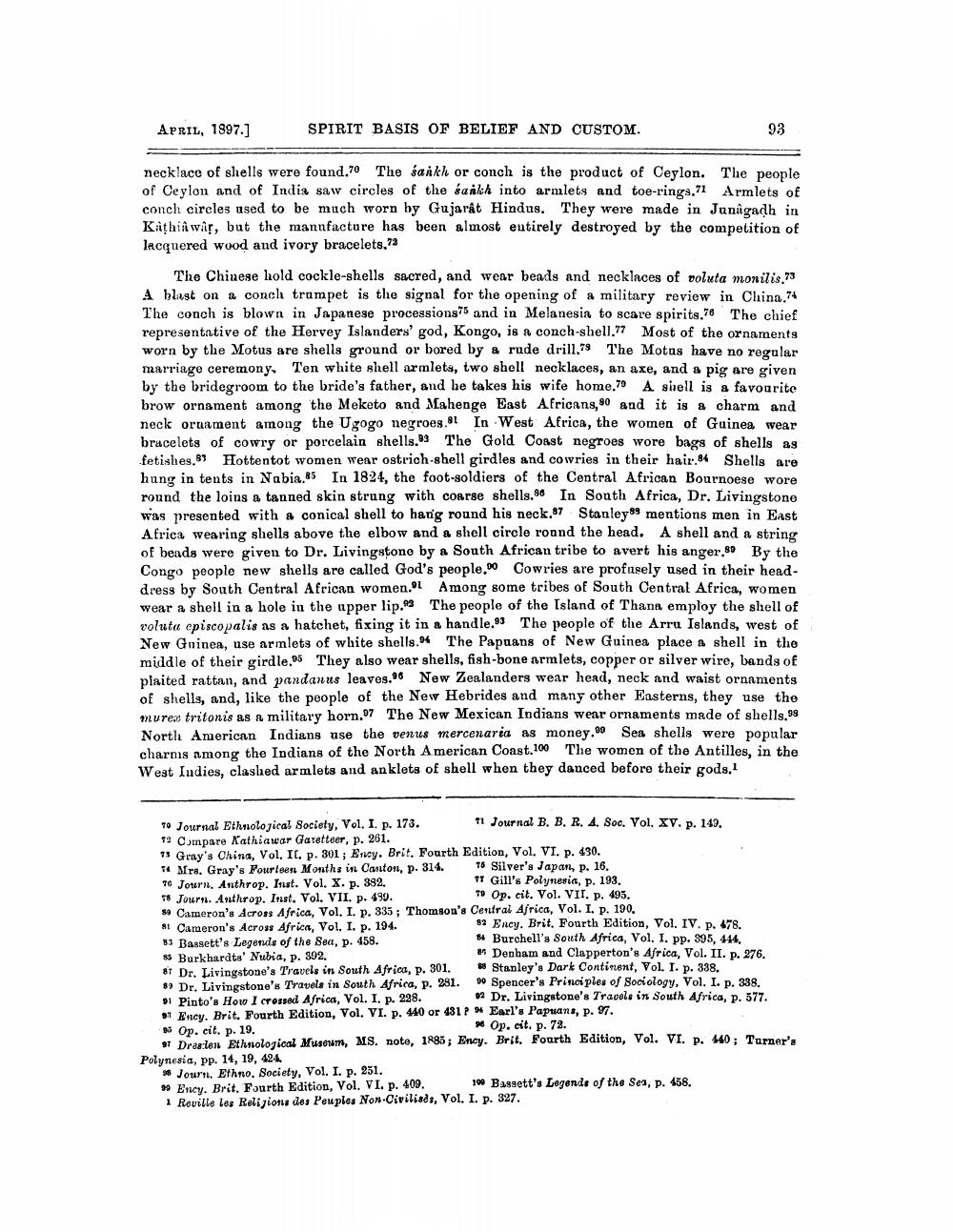________________
APRIL, 1897.]
SPIRIT BASIS OF BELIEF AND CUSTOM
93
necklace of shells were found.70 The saikh or conch is the product of Ceylon. The people of Ceylon and of India saw circles of the saikh into armlets and toe-rings.71 Armlets of conch circles used to be much worn by Gujarat Hindus. They were made in Junagadh in Kithii wir, but the manufacture has been almost entirely destroyed by the competition of lacquered wood and ivory bracelets.72
The Chinese laold cockle-shells sacred, and wear beads and necklaces of voluta monilis.73 A blast on a conch trampet is the signal for the opening of a military review in China.74 The conch is blown in Japanese processions75 and in Melanesia to scare spirits. The chief representative of the Hervey Islanders' god, Kongo, is a conch-shell.77 Most of the ornaments worn by the Motus are shells ground or bored by a rude drill.79 The Motus have no regular marriage ceremony, Ten white shell armlets, two shell necklaces, an axe, and a pig are given by the bridegroom to the bride's father, and he takes his wife home.70 A. shell is a favourite brow ornament among the Meketo and Mahenge East Africans, and it is a charm and neck oruament among the Ugogo negroes.81 In West Africa, the women of Guinea wear bracelets of cowry or porcelain shells.83 The Gold Coast negroes wore bags of shells as fetishes.83 Hottentot women wear ostrich-shell girdles and cowries in their hair.84 Shells are hung in tents in Nabia.85 In 1824, the foot-soldiers of the Central African Bournoese wore round the loins a tanned skin strung with coarse shells.96 In South Africa, Dr. Livingstone was presented with a conical shell to hang round his neck.87 Stanley89 mentions men in East Africa wearing shells above the elbow and a shell circle round the head. A shell and a string of beads were given to Dr. Livingstone by a South African tribe to avert his anger.89 By the Congo people new shells are called God's people. Cowries are profusely used in their headdress by South Central African women. Among some tribes of South Central Africa, women wear a shell in a hole in the upper lip.92 The people of the Island of Thana employ the shell of voluta episcopalis as a hatchet, fixing it in a handle.83 The people of the Arru Islands, west of New Guinea, use armlets of white shells." The Papuans of New Guinea place a shell in the middle of their girdle. They also wear shells, fish-bone armlets, copper or silver wire, bands of plaited rattan, and pandanus leaves. New Zealanders wear head, neck and waist ornaments of shells, and, like the people of the New Hebrides and many other Easterns, they use the murea tritonis as a military horn.97 The New Mexican Indians wear ornaments made of shells.98 North American Indians use the venus mercenaria as money. Sea shells were popular charms among the Indians of the North American Coast.100 "The women of the Antilles, in the West Indies, clashed armlets and anklets of shell when they danced before their gods.
70 Journal Ethnological Society, Vol. I. p. 173.
11 Journal B. B. R. 4. Soc. Vol. XV. p. 149. T! Compare Kathiawar Garetteer, p. 261. 75 Gray's China, Vol. IC. p. 301; Ency. Brit. Fourth Edition, Vol. VI. p. 430. * Mrs. Gray's Fourteen Months in Canton, p. 314. 76 Silver's Japan, p. 16. 76 Journ, Anthrop. Inst. Vol. X. p. 382.
11 Gill's Polynesia, p. 193. 18 Journ. Anthrop. Inst, Vol. VII. p. 439.
70 Op. cit. Vol. VII. p. 495. 89 Cameron's Across Africa, Vol. I. p. 335; Thomson's Central Africa, Vol. I, p. 190. St Cameron's Across Africa, Vol. I. p. 194.
82 Ency. Brit. Fourth Edition, Vol. IV. p. 478. 83 Bassett's Legends of the Sea, p. 458.
# Burchell's South Africa, Vol. I. pp. 395, 444. 85 Burkhardta' Nubia, p. 392.
89 Denham and Clapperton's Africa, Vol. II. p. 276. 87 Dr. Livingstone's Travels in South Africa, p. 301. Stanley's Dark Continent, Vol. I. p. 338. 89 Dr. Livingstone's Travels in South Africa, p. 281. 00 Spencer's Principles of Sociology, Vol. I. p. 338. 91 Pinto's How I crossed Africa, Vol. I. p. 228. 02 Dr. Livingstone's Travels in South Africa, p. 577.
1 Ency. Brit. Fourth Edition, Vol. VI. p. 440 or 431 P 9 Earl's Papuans, p. 97. 05 Op. cit. p. 19.
16 Op. cit. p. 72. 97 Draxlen Ethnological Museum, MS. note, 1885; Ency. Brit. Fourth Edition, Vol. VI. p. 140; Tarner's Polynesia, pp. 14, 19, 424
*6 Jourti. Ethno. Society, Vol. I. p. 251. 19 Ency. Brit. Fourth Edition, Vol. VI. p. 409. 100 Bassett's Legends of the Sea, p. 458. 1 Reville les Religions des Peuples Non-Civiliads, Vol. I. p. 327.




